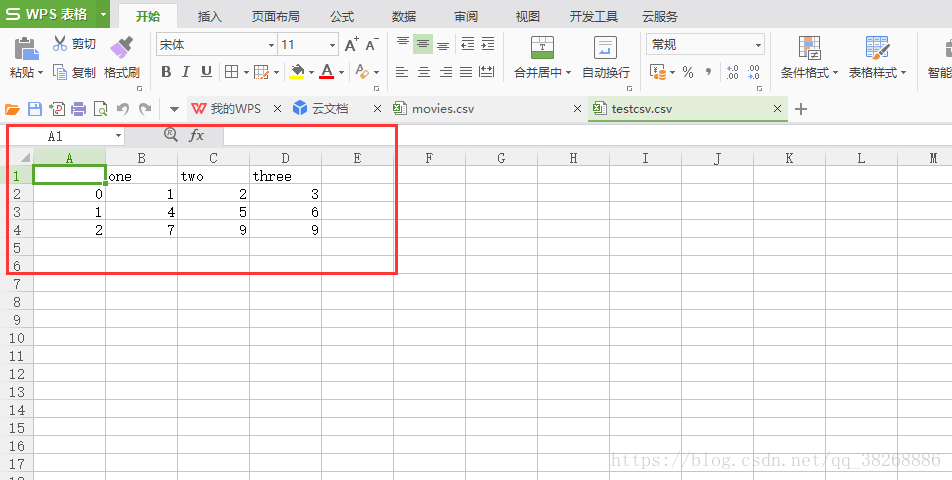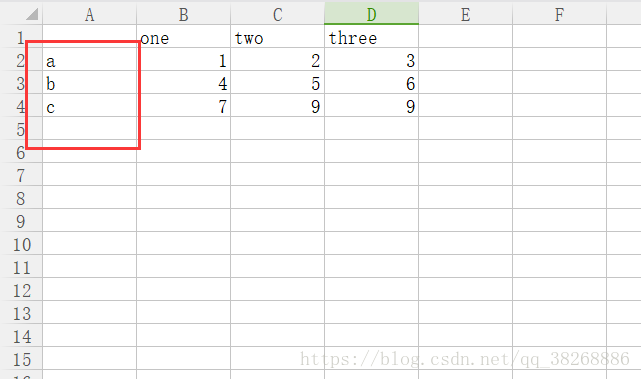Python將list元素轉(zhuǎn)存為CSV文件的實(shí)現(xiàn)
首先先定義一個list,將其轉(zhuǎn)存為csv文件,看將會報什么錯誤
list=[[1,2,3],[4,5,6],[7,9,9]]list.to_csv(’e:/testcsv.csv’,encoding=’utf-8’)
運(yùn)行后出現(xiàn):
Traceback (most recent call last): File 'D:/Python/untitled/PcCVS.py', line 43, in <module> list.to_csv(’e:/testcsv.csv’,encoding=’utf-8’) AttributeError: ’list’ object has no attribute ’to_csv’
list沒有to_csv的屬性,也就是說list直接是轉(zhuǎn)存不了為csv 為了解決這個問題,我們可以引入panas模塊,使用其DataFrame屬性。
import pandas as pdlist=[[1,2,3],[4,5,6],[7,9,9]]# 下面這行代碼運(yùn)行報錯# list.to_csv(’e:/testcsv.csv’,encoding=’utf-8’)name=[’one’,’two’,’three’]test=pd.DataFrame(columns=name,data=list)#數(shù)據(jù)有三列,列名分別為one,two,threeprint(test)test.to_csv(’e:/testcsv.csv’,encoding=’gbk’)
運(yùn)行結(jié)果為:

生成的csv文件為:

默認(rèn)的行名是從0開始遞增的數(shù)字,要是不喜歡這個表示,也可以自己改,改成自己喜歡的.只需要在pd.DataFrame()中定義一個index參數(shù),具體如下:
import pandas as pdlist=[[1,2,3],[4,5,6],[7,9,9]]name=[’one’,’two’,’three’]name2=[’a’,’b’,’c’]test=pd.DataFrame(columns=name,index=name2,data=list)print(test)test.to_csv(’e:/testcsv.csv’,encoding=’gbk’)
這樣就就修改好了

到此這篇關(guān)于Python將list元素轉(zhuǎn)存為CSV文件的實(shí)現(xiàn)的文章就介紹到這了,更多相關(guān)Python list元素轉(zhuǎn)存為CSV內(nèi)容請搜索好吧啦網(wǎng)以前的文章或繼續(xù)瀏覽下面的相關(guān)文章希望大家以后多多支持好吧啦網(wǎng)!
相關(guān)文章:
1. 在Android中使用WebSocket實(shí)現(xiàn)消息通信的方法詳解2. Yii2.0引入CSS,JS文件方法3. JSP數(shù)據(jù)交互實(shí)現(xiàn)過程解析4. Nginx+php配置文件及原理解析5. python matplotlib:plt.scatter() 大小和顏色參數(shù)詳解6. 常用數(shù)據(jù)庫JDBC連接寫法(轉(zhuǎn)摘)7. Python importlib動態(tài)導(dǎo)入模塊實(shí)現(xiàn)代碼8. JavaMail 1.4 發(fā)布9. 淺談python出錯時traceback的解讀10. vue使用webSocket更新實(shí)時天氣的方法

 網(wǎng)公網(wǎng)安備
網(wǎng)公網(wǎng)安備